How to position a SaaS when there are multiple customer profiles (Plus: template for choosing the right market)
Last updated: December 20th, 2021
It’s extremely difficult to speak to everyone at once — but that’s what a lot of B2B SaaS companies try to do when they have multiple customer profiles. As a result, they create one-size-fits-all marketing that doesn’t speak to anyone.
Many companies have products with good traction that serve a well-defined industry and work for customers of all sizes.
This is a total nightmare to grow. Enterprise customers and solo businesses have radically different needs, and it’s extremely difficult to speak to everyone at once. Unfortunately, many founders jump straight to blaming their product for their lack of success, when a simple positioning shift can make the difference they need.
When we start working with a B2B SaaS company, they often have mutliple customer profiles to reach. We have a process that helps them:
- Identify if they are trying to speak to too many people at once.
- Understand their goals for marketing and growth for the future.
- Identify their best-fit customers using metrics like annual recurring revenue (ARR), lifetime value (LTV), customer satisfaction, engagement with product, market penetration, and desirability.
- Reposition across the board for the best-fit customer.
Thoughtfully crafted and data-driven positioning can help make your offerings more relevant to the audiences you are trying to reach.
After reading this post, you’ll have a solid understanding of how to use data to identify your ideal customer and how to use positioning to achieve high growth.
Want to get a clearer picture your customers and strong positioning? Schedule a Free SaaS Scale Session to find out how we can help you nail your positioning and win more customers.
How we helped one client improve their positioning by narrowing their market
Positioning works best when it is clear who a product is for. Companies can say that their product is for everyone, but this dilutes the power of their messaging and product.
Our client, a top legal case management startup, has a product that works for different industry use cases. Not only is their product multifaceted and diverse, but it also can be used by single lawyer firms and enterprise sized firms alike.
But the needs of one segment are radically different from the needs of another
When we started working with the client, many of their customers liked the product but there was also a lot of confusion in the marketing messages because their customer’s needs were so diverse.
We identified that our client wasn’t hitting on any of their customer’s specific pain points, speaking generally to benefits and offerings in their messaging.
The one-size-fits-all messaging was impacting their growth and conversions.
With high-growth targets to hit on the horizon, we suggested that the client revisit their positioning and focus their attention on one singular customer segment.
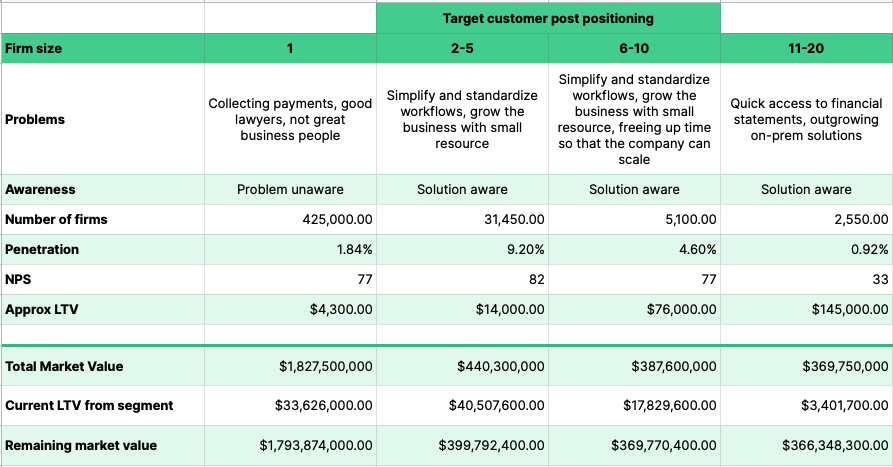
To help, we focused on their highest net promoter score (NPS) group with the best opportunity for growth in terms of the total addressable market (TAM). We used data to decide which ideal customer profile (ICP) to double down on.
The ICP post-positioning is the one with the most beneficial acquisition economics.
Even though the single person firms segment has much more revenue available, the LTV is too low to acquire many people profitably.
That’s why choosing the firms that have 2-10 lawyers in them makes the most sense.
The ‘beachhead customer’
Saying “no” is part of positioning. While it may seem like your company will lose out on potential sales, you’re actually setting yourself up for greater success.
When a military invades somewhere, it lands on a beach rather than a coast, because it will have a higher chance of getting to shore. From there, it can launch further attacks.
This is called a ‘beachhead’ and the concept transfers well into marketing where we can think of a market as having ‘beachhead customers.’
By identifying a targeted segment, or “beachhead customer,” you can zero in on positioning and messaging that works for a high-growth ICP and use those learnings to expand to adjacent markets.
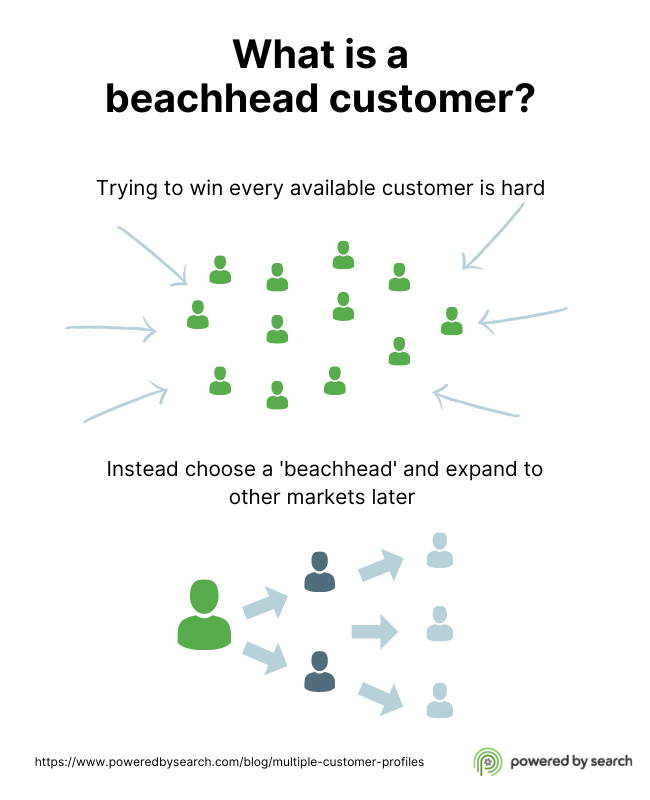
This works the same way for positioning and market choice.
When SaaS companies spread themselves too thinly across many customer profiles, they will suffer consequences that impact their bottom line, including:
- Confusing and alienating prospects who visit their website
- Failing to gain market share
- Filling their pipeline with low-quality leads
- Struggling to build a strong brand that inspires trust
Companies that grow the fastest do so by committing to one segment in their industry.
This creates a significantly better opportunity for you. Rather than having two sets of diluted, ineffective messaging, you can nail one down and only add additional markets when you have the bandwidth to position yourself well.
Let’s look at how you can identify your beachhead market and effectively tailor your positioning.
How to use data to identify high-growth customer segments
To position your product well, you must first identify your ideal customer profile (ICP).
Remember: you want right-fit customers who stay around and pay you over a long time because your product solves their problems well. You don’t want high value customers who pay you only for a very short amount of time.
Dig deep into your personas and customer data to identify the types of people you are serving.
Try to create 3-4 ‘buckets’ at a maximum.
Once you’ve done that, take a look at the bigger picture:
What’sthe company goal for the next 2-3 quarters?
This goal will shape how you approach the positioning exercise and will help you surface which ICP to hone in on.
Mapping your business goals to your ICPs can give you a better idea of which segments have higher growth potential and where you, as a company, would like to be in the future.
Here’s how we do this process with our SaaS clients.
Use data to choose the right customer segment
To choose the best customer, you should focus on a small set of mostly revenue focused metrics.
Avoid vanity metrics, and instead zero in on data that is related to the things that caused your company to grow.
Be as objective as possible here, gathering inputs and recommendations informed by revenue metrics, engagement metrics and internal support metrics. We recommend the folloing:
- ARR
- LTV
- Customer satisfaction (NPS, CSAT)
- Engagement with product (in-product actions and onboarding completion)
- Market penetration
- Desirability (if you can’t stand your customer, you’re going to hate your working life)
Then build a simple spreadsheet to put this data into – use columns for each individual market segment. You can use a template that we’ve put together:
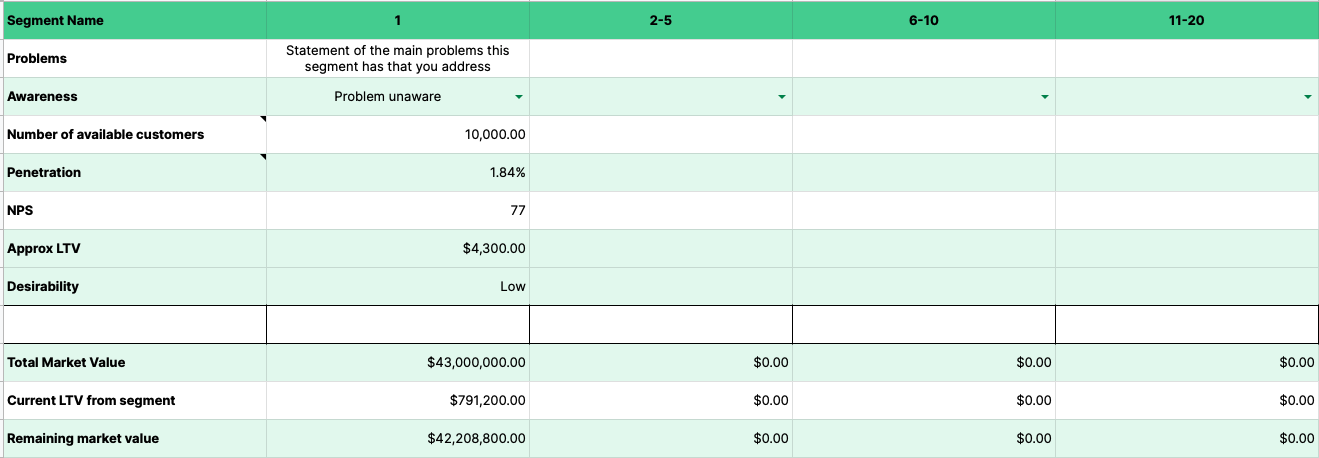
When you’re collecting the data to help make your choice, focus on the quantitative first.
Speaking to customers is helpful, but not until you have gathered specific data. You need a theory about who your best market is, and the best way to come up with that is by using hard data.
Once you have this data, you can test your theory on different customer segments with qualitative methods, including surveys and customer interviews.
You can also interact with churned customers to understand more about their experience.
Factor information on churned customers into your segmentation identification process and understand the reason why they left (especially in your beachhead customer segment, once you’ve determined which group that is).
A bit of foresight can help you prevent other customers in the same segment from churning.
Once you have this data, look at the following:
- Which segment has the highest remaining market value for you?
- Which segment has the best acquisition economics?
- Which segment has the best economics and is one you actually like?
Consider this data from our client example:
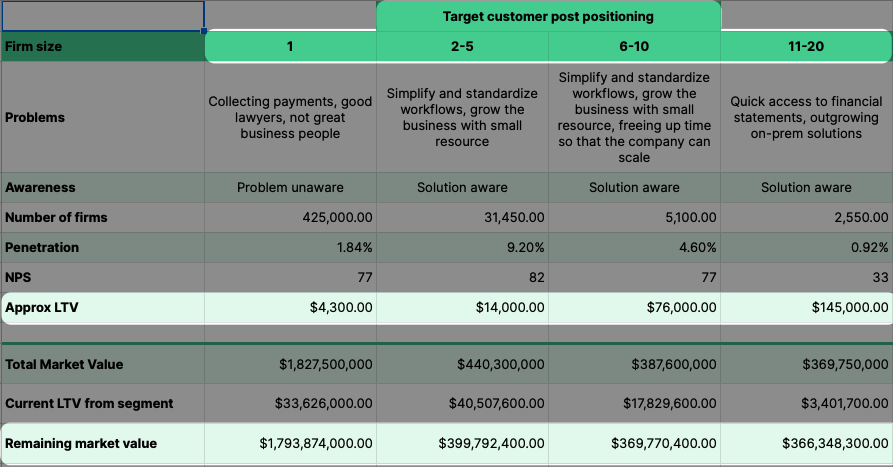
Working through the answers to the above questions:
- The segment with the highest remaining value by some distance is single lawyer firms
- The segment with the best acquisition economics is actually large firms – you could spend a lot to acquire a customer with an LTV of $145K
- The NPS of large firms is extremely poor and the customer awareness of single firms is also very poor
That’s why we recommended our clients merge the middle two markets segments into 2-10 lawyer firms as their problems are quite similar. Additionally, when we combined the rest of the metrics, the market is large and the economics are good!
Identify your ideal customers’ top pain points
Now that you’ve nailed down your market, you need to go through a positioning exercise. Our simple B2B SaaS Positioning Canvas will help you get strong, differentiated positioning each time.
Start by identifying which pain points your best-fit customers have that are solved by:
- Your features
- The way your company does things
- The systems or approaches that distinguish you from your competitors
To find this data, review any touchpoints or interactions you’ve had with your ICP, from sales conversions, customer support tickets, feature suggestions, to even simply interviewing your clients. This data can reveal what your ICP is experiencing and how you and your product can solve their problems.
Now it’s time for the litmus test. Visit existing content across your channels and landing pages, and critically assess with the following lens:
- Is my positioning clear from this copy?
- Am I talking about features that matter to my ICP?
- Am I talking about outcomes that people in my ICP have achieved?
Make changes to your copy and messaging based on your answers to those questions.
Update your positioning and messaging to address your ideal customer’s pain points
Review every piece of content that lives on your site and across all properties through the lens of your ICP. Take a critical look at everything, from landing pages to e-books and even “thank you” pages. What questions would a prospect need answered before they convert?
A positioning exercise is essential, but the way you message your product from there is what will really impact your prospects.
Update your landing pages as a priority but also don’t forget the following marketing materials:
- Social profiles
- Content strategy
- Sales enablement pieces
- Ad copy
- Email copy
- In-app activation flows
- Pricing pages
- Cold outreach and scripting
Refresh all of your marketing materials with the new messaging.
To make this process more effortless in the future, keep a running audit list of all marketing materials, internal and external.
Once our client identified their beachhead customer, we helped them reformulate their messaging. We changed the focus of the language on key pages and materials to speak to the ICP’s unique needs and emphasize the benefits to that specific segment.
Here’s a representation of their landing page before we started working together:
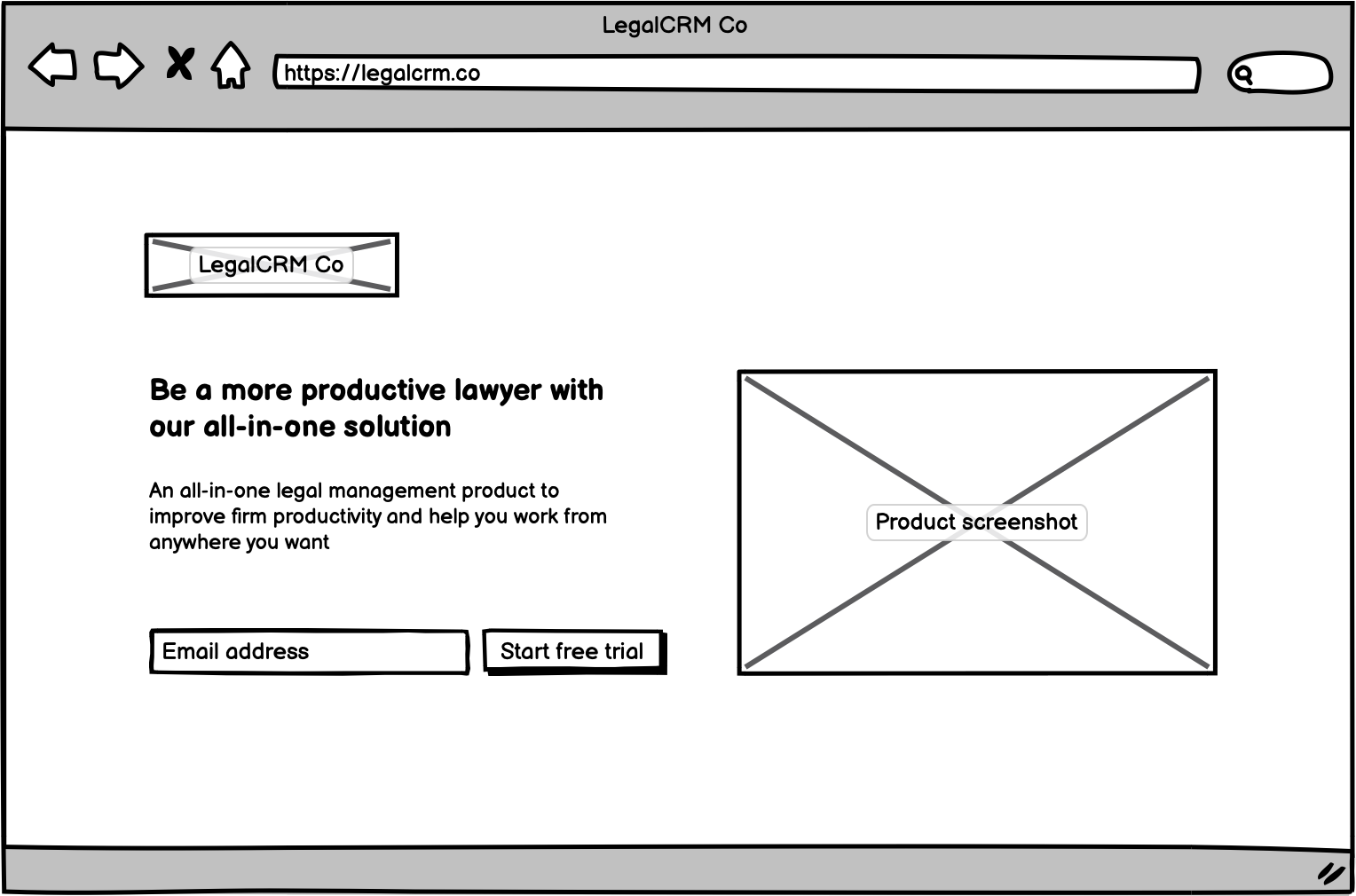
We reduced the ambiguity and added pain-point focused copy and imagery that resonated with their beachhead customer.
These changes helped leads understand which tools they needed to solve their pains or what they were signing up for.
And here’s a wireframe of their post-repositioning landing page hero:
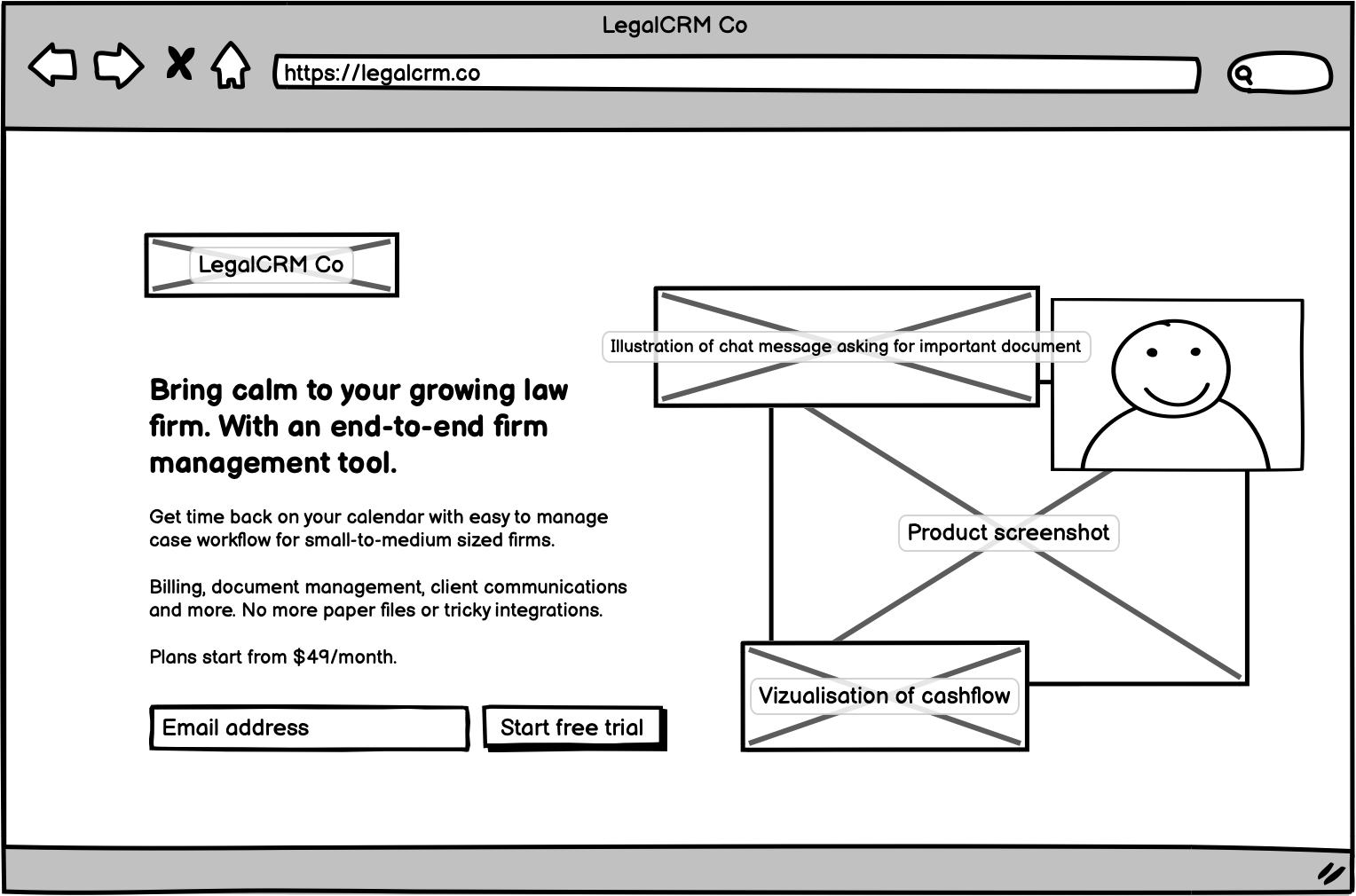
Revisit positioning regularly
Your customers’ needs change all the time, and your positioning should change to match. A suitable cadence for revisiting your positioning is on a quarterly or annual basis, or if your business or growth rate changes substantially.
Here are a couple triggers for revisiting your positioning:
- If you are changing the business materially – Are you going through a period of change where you’re trying to go upmarket or downmarket? Are you trying to reach a whole new customer segment?
- If you are going through fast growth – Check on a regular basis to see if you are moving fast and have high-growth targets. Critically assess if your positioning is yielding results.
In closing
Often, companies fail to recognize that they have a positioning problem caused by having so many customer segments. They keep trying to reach several customer segments with diluted, ineffective messaging.
If you can identify and manage the customer segmentation and positioning process correctly, your SaaS business will see improved customer acquisition and retention metrics as well as an overall impact on the revenue focused metrics.
Clear positioning provides your organization with the clarity and customer focus necessary to speak to your highest-growth customers.
Once you crack that nut, you will no longer need every customer that is willing to pay for your service or product, and you’ll be able to focus on one specific segment of customers that produces the most revenue at the lowest spend.
Want to get a clearer picture your customers and strong positioning? Schedule a Free SaaS Scale Session to find out how we can help you nail your positioning and win more customers
What you should do now
Whenever you’re ready…here are 4 ways we can help you grow your B2B software or technology business:
- Claim your Free Marketing Plan. If you’d like to work with us to turn your website into your best demo and trial acquisition platform, claim your FREE Marketing Plan. One of our growth experts will understand your current demand generation situation, and then suggest practical digital marketing strategies to hit your pipeline targets with certainty and predictability.
- If you’d like to learn the exact demand strategies we use for free, go to our blog or visit our resources section, where you can download guides, calculators, and templates we use for our most successful clients.
- If you’d like to work with other experts on our team or learn why we have off the charts team member satisfaction score, then see our Careers page.
- If you know another marketer who’d enjoy reading this page, share it with them via email, Linkedin, Twitter, or Facebook.